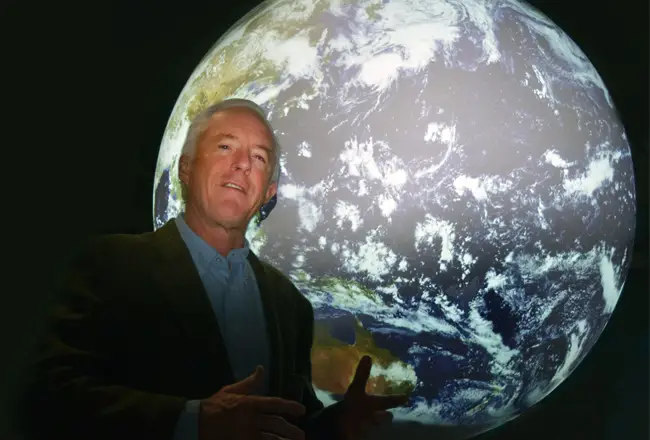
Bill Finch”™s executive director office at the Discovery Museum in Bridgeport is not soundproofed, and every day he absorbs a happy racket from a next-door exhibit that encourages youngsters to interact with hands-on displays related to the basic concepts of aerospace, physics and engineering. However, Finch is not complaining ”” actually, his reaction is quite the opposite.
“I hear screeches and exclamations of ”˜Mommy, look, I did it”™ and ”˜Daddy, come over here because I want to show you this,”™” he said. “And it”™s all day long.”
Finch added, with a gentle laugh, that the youthful exclamations of wonder are a far cry from the comments he used to field when he was Bridgeport”™s mayor from 2007 through 2015. After leaving City Hall, Finch crossed the border to serve as acting director of the New York State Thruway Authority and Canal Corp. and as a fellow at the Rockefeller Institute of Government on climate change-related issues. The chance to return to Bridgeport and run the Discovery Museum caught him off-guard.
“It came out of the blue,” he recalled. “Tom Vos is the chairman and he said, ”˜I have an opportunity that I want to talk to you about.”™ I thought that maybe he”™d want me to sit on the board. I wanted to find out what was going on with the museum, because to me it is one of the most important institutions in Fairfield County. He said, ”˜Let”™s meet for a drink.”™”
Finch was named executive director in January and he was immediately eager to pursue this new challenge. “I was the mayor of a city, now I”™m mayor of a concept,” he said. “Our name is Discovery, and the spirit of discovery is in everybody.”
The institution was founded in 1958 as the Museum of Art, Science and Industry, and Finch is at work finalizing a 60th anniversary celebration schedule. However, his primary focus is using the Discovery Museum to encourage a greater appreciation of STEM (science, technology, engineering and mathematics) education, particularly among communities that have traditionally been underrepresented in the STEM fields. Finch pointed out his office window at Park Avenue, which separates Bridgeport and Fairfield, as an example of disparity gaps that could be bridged via STEM education.
“On that side of the street is Fairfield, where homes are averaging about $1 million,” he said. “On this side of the street, they are averaging $200,000. On that side of the street, the median income is over $100,000. On this side of the street, the median income for a family of four is under $40,000. On this side of this street, you have a 50 percent chance of graduating high school. On that side of the street, you have a 95 percent chance of graduating high school. We are on the edge of the haves and have-nots, and we can do something about that.”
Finch recalled the intellectual and emotional rapture of his childhood with the attention given to meeting President John F. Kennedy”™s goal of a manned moon landing by the end of the 1960s, and he stated that today”™s youth are often surprised to how technology has evolved over the years.
“When I was mayor, I would lecture kids in the high schools about science and I would hold up a cell phone and tell them there”™s more technology in their hands than all of NASA when they landed man on the moon,” he continued. “And they didn”™t believe me. They have more computing power than NASA had. When people tell us we can”™t do stuff, I chuckle because of course we can. We have to have the will, and we have to have to population that understands why we”™re doing it ”” and that”™s where we come in.”
Getting more people to come into the Discovery Museum is also on Finch”™s agenda. The museum averages an attendance rate of 65,000 per year, and Finch is eager to expand its social media presence and coordinate more in-school visits by museum staff to talk up STEM subjects. The museum”™s financing is divided between 10 percent state funding and 90 percent via fundraising efforts, which Finch said mirrored the current state of scientific funding via a surplus of private sector input. “The government doesn”™t row the boat so much as it steers it,” he observed.
Finch is especially interested in raising the Discovery Museum”™s visibility with regional companies seeking venues for team-building exercises. He promised an intergalactic alternative to the “boring hotel” setting via the museum”™s Challenger Learning Center, Finch stated can be configured to force participants to work together in solving problems that are literally out of this world.
“I can take you to outer space and simulate a space mission for you,” he said. “I can throw disasters at your team, and that the person they don”™t particularly like is going to save their lives on a space mission.”
Also on tap for the Discovery Museum is an updated exhibit on Gustave Whitehead, the Bridgeport-based aviator who claimed to have achieved a controlled manned flight in 1901, two years ahead of the Wright Brothers. While many aviation historians have disbelieved the claims put forth by Whitehead”™s advocates that he was first in flight, Finch believed it was crucial to present an objective consideration of Whitehead”™s contributions to aviation history.
“I don”™t think it is as important as to who flew first, but that we present information about both cases and let the individuals decide,” he said. “He had many firsts, including the first to use aluminum and wheels on an airplane and an acetylene powered engine. We”™re not here to tell people what to believe when they see our exhibits ”” we want them to think critically and understand the scientific methods. He was a man of courage and he epitomized discovery.”
While Finch is reshaping the Discovery Museum, his successor at City Hall, Mayor Joe Ganim, is aiming to become Connecticut”™s next governor. In the event that Ganim gains the top statewide office, Finch expressed no interest in seeking a return to his old job.
“No, I am really happy here,” he said. “I think that I can have just as much impact here as anywhere.”























I am very pleased to hear that Mr. Finch is now Executive Director of the Discovery Museum. As a longtime Gustave Whitehead researcher and author of “Gustave Whitehead: First in Flight” (2105), and one who has loaned the Discovery Museum artifacts concerning Gustave Whitehead, I believe that Bill Finch is uniquely suited to preserve and expand the Whitehead collection and bring his important story to families in the region.